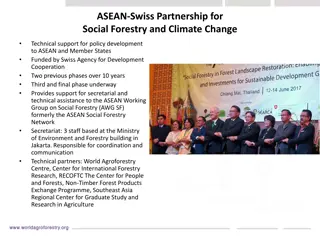Evolution of Agriculture Practices in the Central USA: A Sustainable Future Perspective
The evolution of agriculture practices in the Central USA, from historical land use changes to the decline in crop diversity and the emergence of bioenergy solutions, reflects a shift towards sustainability. With a focus on utilizing marginal lands and promoting diversified crop-livestock-bioenergy systems, there is potential for a more resilient and eco-friendly agricultural landscape.
Download Presentation

Please find below an Image/Link to download the presentation.
The content on the website is provided AS IS for your information and personal use only. It may not be sold, licensed, or shared on other websites without obtaining consent from the author.If you encounter any issues during the download, it is possible that the publisher has removed the file from their server.
You are allowed to download the files provided on this website for personal or commercial use, subject to the condition that they are used lawfully. All files are the property of their respective owners.
The content on the website is provided AS IS for your information and personal use only. It may not be sold, licensed, or shared on other websites without obtaining consent from the author.
E N D
Presentation Transcript
World Bioenergy Congress and Expo Bioenergy: A Step Toward a Sustainable Future Back to the Future: a Perspective from the Central USA Rob Mitchell WBCE Organizing Committee June 13, 2016 Rome, Italy
Land use change & concern for marginal land is not new In the Central USA, European settlement & farming began in the 1860 s. The Dust Bowl (a period of severe drought from 1928-1937) was the first large-scale indicator that farming practices were not sustainable. Millions of acres of marginal cropland & overgrazed grassland had to be reseeded to correct this ecological & economic disaster. From 1920 to 1954, the number of horses & mules in the US dropped from 27 to <5 million, releasing ~80 million acres of pasture & hay for other uses. Recent years have witnessed a growing interest in the possibilities of a more rational use of land in the US . on those areas of such physical character or situation that the returns to production are either meager or precarious. Peterson & Galbraith, 1932
Perennial grasses arent new Perennial grasses dominated the central US landscape for millenia. Since 1935, USDA-ARS & universities have developed improved perennial grass cultivars & associated management practices for use on marginal cropland in the Central US for grazing, hay, conservation, & bioenergy. Ken Vogel 1975-2014 L.C. Newell 1935-1975
Crop diversity declined dramatically after the 1960s Settlement to 1970 - most farms in the central USA were characterized by diversified crop & livestock production (survive, sustain, succession) -Most farms grew corn, sorghum (grain & forage), wheat, alfalfa, soybean, sugar beets, perennial pasture, cattle (beef & dairy), hogs, horses, sheep, & chickens 1970 to Present - Diversified systems have become abnormal in the central USA (increase, incorporate, intermission) -Corn-soybean rotation dominates the farmscape Bioenergy 1st Gen biofuels from corn grain; 2nd Gen biofuels from corn stover; provides an opportunity to change the culture of agriculture to a modern diversified crop-livestock-bioenergy production system
Historic trends in crop production in Nebraska 1969 1982 1997 2012 Change, % -------------------- Hectares -------------------- Corn (grain) 107% 1,778,529 2,640,296 3,353,197 3,680,580 Corn (silage & forage) 24% 146,297 155,710 84,883 180,786 3,861,366 101% 2,018,217 661% 24,304 -96% 4,729 -93% Total Corn Soybean 1,924,826 2,796,007 3,438,080 265,258 852,855 1,355,414 Sorghum (grain) 591,821 671,181 2,91,712 Sorghum (silage & forage) 72,589 32,652 10,745 Wheat -47% 78% 994,309 1,046,970 717,688 530,254 Total 5,773,6298,195,672 9,251,71910,300,237 NASS, 2016
World Bioenergy Congress and Expo Demand for food, feed, fiber, & fuel will continue to escalate as the world population increases. Research in the USA continues to cast doubt on the long-term sustainability of monoculture row crops like corn and soybeans on marginally productive cropland. Rather than retire this cropland as has been done during the last 3 decades, growing herbaceous and woody perennials provides an excellent opportunity for biomass feedstock production to meet the fuel and livestock feed demand. The science supports that strategically growing perennial biomass feedstocks on a small percentage of the marginally productive cropland can reap significant environmental benefits.
Crop-Livestock-Bioenergy Demonstration Site UNL Agricultural Research & Development Center This working lands approach to growing perennial bioenergy feedstocks on marginally productive cropland is in many ways a look back to the future , returning to a diverse crop system. In my opinion, a biobased economy in the USA will be more similar to agricultural production of the 1950 s than what we see today, but coupled with recent technological advancements.
World Bioenergy Congress and Expo During the next two days we will hear cutting edge research updates from about 20 countries. Prepare to be challenged, excited, and inspired by the upcoming meeting. Thank you to the organizing committee, all of the speakers, and invited guests. I wish you every success in your discussions and a very pleasant stay in Rome!























